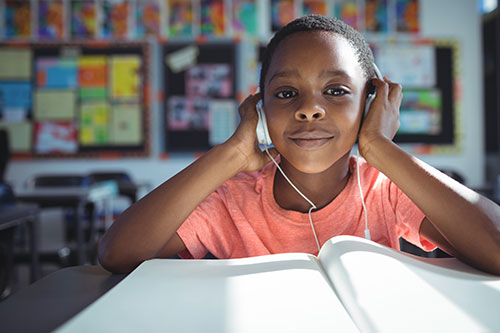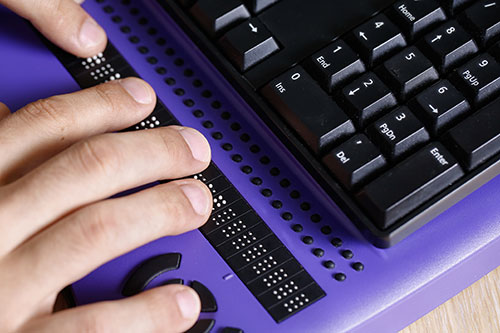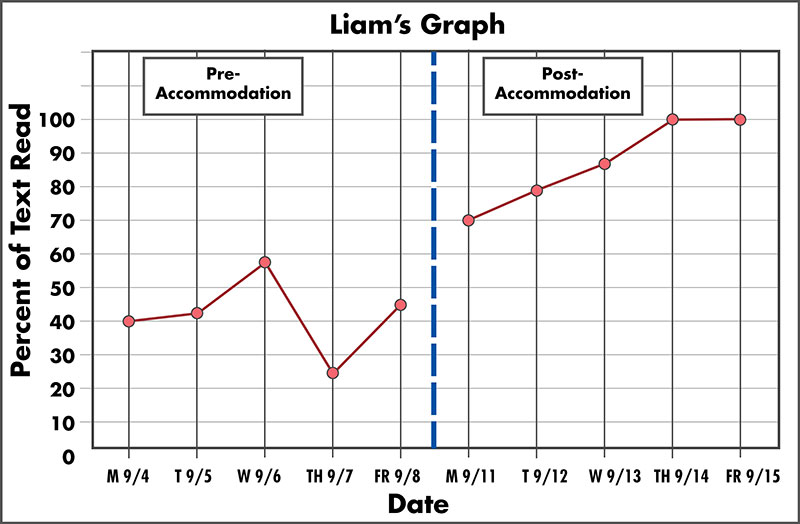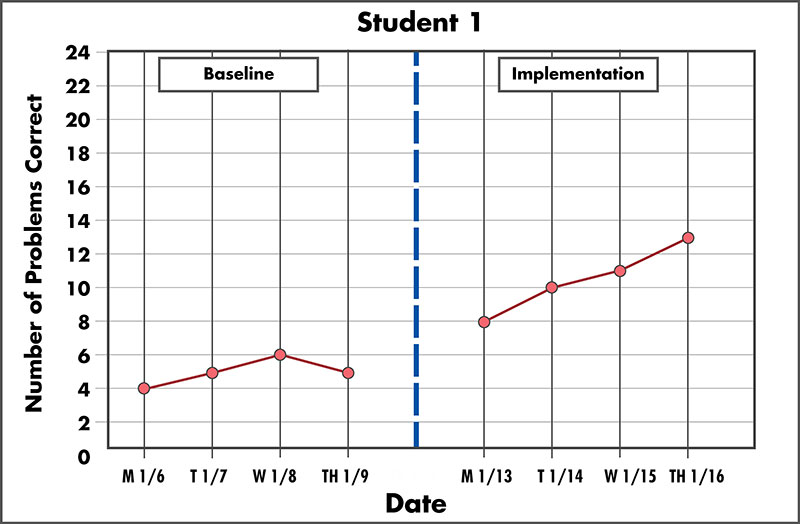Understanding Accommodations
 More than ever, school personnel are responsible for providing high-quality instruction to all students. Together, the Every Student Succeeds Act (ESSA) and the Individuals with Disabilities Education Improvement Act (IDEA) have increased the expectation that students with disabilities will participate in the general education classroom as well as in state and district testing to the greatest extent possible. Unfortunately, students with disabilities often experience challenges or barriers that interfere with their ability to access and demonstrate learning. Barriers to learning can be associated with:
More than ever, school personnel are responsible for providing high-quality instruction to all students. Together, the Every Student Succeeds Act (ESSA) and the Individuals with Disabilities Education Improvement Act (IDEA) have increased the expectation that students with disabilities will participate in the general education classroom as well as in state and district testing to the greatest extent possible. Unfortunately, students with disabilities often experience challenges or barriers that interfere with their ability to access and demonstrate learning. Barriers to learning can be associated with:
- The way information is presented (e.g., text, lecture)
- The way the student is required to respond (e.g., writing, speech)
- The characteristics of the setting (e.g., noise, lighting)
- The timing and scheduling of instruction (e.g., time of day, length of assignment)
What is an accommodation?
Teachers can address these barriers by providing students with accommodations—adaptations or changes in educational environments or practices that help students overcome the barriers presented by their disability. Two areas in which accommodations can be used are instruction and testing.
- Instructional accommodations are changes to the delivery of classroom instruction or the accompanying materials. Instructional accommodations change how students learn but do not change what they learn. In other words, they do not change the scope or range of the grade-level content standards, nor do they alter the complexity of the knowledge students are expected to learn. Students with disabilities who use instructional accommodations are required to learn the same content at the same level of proficiency as their peers who do not use instructional accommodations.
- Testing accommodations are changes to the format of a test or its administration procedures. Testing accommodations change how students are tested but do not change what a test measures. Commonly used testing accommodations include having the test read aloud, allowing for extended time, permitting scribes or dictation, and giving the test in a small-group setting.
Whether for instruction or testing, accommodations provide students with opportunities to achieve the same outcomes and to obtain the same benefits as students without disabilities. By addressing barriers, accommodations create better access to learning opportunities for students with disabilities. For some students, these barriers can be relatively simple to address. For example, a student who has difficulty with fine-motor skills and struggles to hold a pencil might require a pencil grip to help her write out her responses. For others, addressing the barrier can be more complex. For instance, a student who has a visual disability and cannot access written materials might require Braille materials. To better understand how accommodations can address barriers presented by a student’s disability, see the table below.
| Disability Category | Barrier | Example Accommodations |
| Visual disability | Reading printed text |
|
| Specific learning disability | Decoding text |
|
| ADHD | Remaining focused |
|
| Orthopedic impairment | Writing out responses (due to inability to hold a pencil) |
|
Accommodations provide support that allows students with disabilities to achieve the same instructional goals as students without disabilities. It’s important to note that accommodations:
- Do not change the expectations for learning
- Do not reduce the requirements of the task
- Do not change what the student is required to learn
Teachers should provide accommodations that meet the unique needs of each individual student. Not all students with the same disability or even those who experience the same barrier will benefit from the same accommodation. For example, not all students with visual impairments will benefit from Braille materials; some might be better served by audio books.
It is a common misconception that accommodations offer an unfair advantage to students with disabilities. Used appropriately, accommodations level the playing field, allowing students with disabilities the opportunity to perform tasks as well as students without disabilities.
Instructional Practices Often Confused with Accommodations
Teachers use a number of instructional practices to improve their students’ learning. It is not unusual for several of these—specifically, modifications, instructional strategies, and interventions—to be confused with accommodations. In the sections below, we’ll describe each of these practices and explain what makes them different from accommodations.
Modifications
Modifications are adaptations that change what students learn and are used with students who require more support or adjustments than accommodations can provide. Whereas accommodations level the playing field, modifications change the playing field. Unlike accommodations, modifications:
- Do change the expectations for learning
- Do reduce the requirements of the task
The table below lists some modifications that could address the barriers presented by students’ disabilities. Note that the modifications actually change or modify the expectations or requirements of the task.
| Disability category | Barrier | Example Modifications |
| Visual disability | Reading printed text | Alternate assignment |
| Specific learning disability | Decoding text | Read a lower-level book |
| ADHD | Remaining focused | Fewer homework questions |
| Orthopedic impairment | Writing out responses | Shorter report |

Margaret J. McLaughlin, PhD
Professor and Associate Dean, Special Education
University of Maryland, College Park
Instructional Strategy or Intervention
Another way teachers often help struggling students is to implement an instructional intervention or strategy, both of which involve teaching the students to work through a series of steps to improve in an area of deficit or remediate a certain set of skills. Unlike accommodations, strategies or interventions do not specifically address the barriers presented by a student’s disability; rather, they address a skill or knowledge deficit. To further complicate matters, accommodations can be used in conjunction with interventions. The table below lists a few areas in which students often struggle and contrasts example instructional interventions or strategies with examples of accommodations that might be used to help students be successful in class.
| Area of Deficit | Example Instructional Intervention or Strategy | Example Accommodations |
| Reading comprehension | Collaborative Strategic Reading (CSR) |
|
| Mathematics computation | Mnemonic device (e.g., Please Excuse My Dear Aunt Sally) |
|
| Regulating behavior | Self-monitoring of behavior |
|
For Your Information
Teachers might believe that, if they are already using differentiated instruction or Universal Design for Learning (UDL), they do not need to provide accommodations for students with disabilities. Although these approaches might meet the needs of many, some students with disabilities will require the further support or services that accommodations offer.
Activity
Each of the following scenarios introduces a student with a disability and identifies his or her related challenge. For each student, the teacher implements several types of supports. Determine whether each support is an accommodation, modification, or strategy/intervention.
-
Danica, a student with a learning disability (LD), struggles with writing. Her teacher has assigned the class to research a planet using a minimum of three sources and then to write a five-paragraph essay about that planet. Because Danica produces few complete sentences and ideas when given a writing task, her teacher implements several types of support to help her complete the assignment.
TREE (Topic sentence, Reason, Explanation, Ending), a mnemonic device student can use to organize their ideas  Accommodation
Accommodation Modification
Modification Strategy/interventionTREE is a strategy that outlines the steps for writing an essay.
Strategy/interventionTREE is a strategy that outlines the steps for writing an essay.The teacher color codes key information in her materials  Accommodation
Accommodation Modification
Modification Strategy/interventionBy coloring coding key information in the materials, the teacher helps Danica to identify main ideas; however, this does not change the learning expectation, which is to write a five-paragraph essay.
Strategy/interventionBy coloring coding key information in the materials, the teacher helps Danica to identify main ideas; however, this does not change the learning expectation, which is to write a five-paragraph essay.Shorten the writing assignment to one paragraph containing three facts  Accommodation
Accommodation Modification
Modification Strategy/interventionShortening the writing assignment is a modification because it alters the learning expectation.
Strategy/interventionShortening the writing assignment is a modification because it alters the learning expectation. -
A 6th-grade student with ADHD, Brody has difficulty organizing his time. His social studies teacher assigns a long-term project that involves researching the history of their town. The assignment includes the following requirements: visit the local library to complete a demographic information sheet, interview three people who have lived in the town since childhood, and create a presentation using that information. Because the teacher knows that Brody has difficulty completing long-term assignments by the due date, she implements several types of support to help him to do so.
Break the assignment into smaller pieces (e.g., week 1—visit the local library to complete demographic information sheet; weeks 2 and 3— interview three people who have lived in the town since childhood)  Accommodation
Accommodation Modification
Modification Strategy/interventionBreaking the assignment into smaller pieces is an accommodation because it does not change the learning expectation for the student.
Strategy/interventionBreaking the assignment into smaller pieces is an accommodation because it does not change the learning expectation for the student.Teach the student to schedule and monitor his time  Accommodation
Accommodation Modification
Modification Strategy/interventionTeaching the student to schedule and monitor his time is a time-management strategy.
Strategy/interventionTeaching the student to schedule and monitor his time is a time-management strategy.Complete a homework packet on the same topic instead of the project  Accommodation
Accommodation Modification
Modification Strategy/interventionCompleting a homework packet on the same topic is an alternate assignment that changes the expectations for learning and the requirements of the task.
Strategy/interventionCompleting a homework packet on the same topic is an alternate assignment that changes the expectations for learning and the requirements of the task. -
Aliyah, a middle school student with muscular dystrophy, often experiences physical fatigue. She is a highly motivated student and excels academically. Her language arts, mathematics, science, and social studies teachers typically assign homework that requires access to the textbooks used in each of these classes. Because her teachers realize that carrying heavy textbooks home each night is difficult for Aliyah, they implement several types of support to help her complete her assignments.
Provide access to online textbooks  Accommodation
Accommodation Modification
Modification Strategy/interventionProviding access to online textbooks is an accommodation because it does not change what the student is required to do; it simply removes the barrier—lack of physical strength, which results in her inability to carry textbooks.
Strategy/interventionProviding access to online textbooks is an accommodation because it does not change what the student is required to do; it simply removes the barrier—lack of physical strength, which results in her inability to carry textbooks.Provide a different assignment that does not require the textbook  Accommodation
Accommodation Modification
Modification Strategy/interventionProviding a different assignment that does not require the textbook is a modification because it changes the expectations for learning.
Strategy/interventionProviding a different assignment that does not require the textbook is a modification because it changes the expectations for learning.Allow her to keep a set of textbooks at home  Accommodation
Accommodation Modification
Modification Strategy/interventionAllowing her to keep a set of textbooks at home is an accommodation because it does not change what the student is required to do; it simply removes the barrier—lack of physical strength, which results in her inability to carry textbooks.
Strategy/interventionAllowing her to keep a set of textbooks at home is an accommodation because it does not change what the student is required to do; it simply removes the barrier—lack of physical strength, which results in her inability to carry textbooks. -
Ahmed, a high school student with an intellectual disability, reads at a 2nd-grade level. Because he has difficulty with decoding words, he is not able to read fluently enough to comprehend what he has read. His special education teacher has noticed that he typically understands and remembers the information that she presents orally. For this reason, his teacher implements several types of support to help him succeed in the classroom.
Allow him to use text-to-speech software—text will be read to him  Accommodation
Accommodation Modification
Modification Strategy/interventionText-to-speech software is an accommodation because it allows the student to access the content but does not change the learning expectation. In this case, the learning expectation is comprehension, not decoding.
Strategy/interventionText-to-speech software is an accommodation because it allows the student to access the content but does not change the learning expectation. In this case, the learning expectation is comprehension, not decoding.Explicitly teach phonics to improve decoding skills  Accommodation
Accommodation Modification
Modification Strategy/interventionExplicitly teaching phonics is a strategy to improve a student’s decoding skills.
Strategy/interventionExplicitly teaching phonics is a strategy to improve a student’s decoding skills.Give him a lower-level reader that provides fewer facts and details  Accommodation
Accommodation Modification
Modification Strategy/interventionProviding a lower-level reader is a modification because it changes the expectations for learning.
Strategy/interventionProviding a lower-level reader is a modification because it changes the expectations for learning.
Selecting an Accommodation
For some students with disabilities, instructional or testing accommodations are documented on their individualized education programs (IEP) or 504 plans. When this is the case, teachers are required to provide those accommodations. There are instances, however, when students with disabilities continue to struggle even with the accommodations in place or they begin to struggle in a new area. When either occurs, the teacher might want to try a new accommodation. If the teacher identifies a beneficial accommodation, the IEP team should convene to determine whether it should be added to the student’s IEP.
Before teachers can select an accommodation, they must first identify the barrier that is interfering with the student’s learning and consider how that barrier is affecting his or her performance. Identifying the student’s barrier can help the teacher to determine the type of accommodation that will likely support the student.
Consider Liam
 Liam, a middle school student, has low vision and struggles with reading standard print materials in a timely fashion. Although he reads at grade level, he has difficulty finishing science reading assignments in class in the allotted time. At first, his teacher was a bit perplexed: she assumed that Liam’s glasses provided full vision correction. However, after observing Liam while he was reading, she noticed that he still needs to hold reading material close to his face, and even then he squints. As a result, it takes him longer to read a passage. She wonders what type of accommodation will help Liam read text faster or more efficiently.
Liam, a middle school student, has low vision and struggles with reading standard print materials in a timely fashion. Although he reads at grade level, he has difficulty finishing science reading assignments in class in the allotted time. At first, his teacher was a bit perplexed: she assumed that Liam’s glasses provided full vision correction. However, after observing Liam while he was reading, she noticed that he still needs to hold reading material close to his face, and even then he squints. As a result, it takes him longer to read a passage. She wonders what type of accommodation will help Liam read text faster or more efficiently.
Accommodations are typically grouped into four categories: presentation, response, setting, and timing and scheduling. Teachers can use the table below to determine the type of accommodation that would best support the student given the student’s barrier.
| Barrier | Accommodation Category | Examples |
| The way information is presented (e.g., text, lecture) | Presentation accommodations
|
|
| The way in which the student is required to respond (e.g., writing, speech) | Response accommodations
|
|
| The characteristics of the setting (e.g., noise level, lighting) | Setting accommodations
|
|
| The timing and scheduling of the instruction (e.g., time of day, length of assignment) | Timing and scheduling accommodations
|
|
Consider Liam
 To address Liam’s barrier—reading standard print—the teacher decides to provide him with a digital textbook that allows him to enlarge the text (a presentation accommodation). She hopes this will help him read more efficiently and complete science reading assignments in the allotted time because he will not be straining to read small print.
To address Liam’s barrier—reading standard print—the teacher decides to provide him with a digital textbook that allows him to enlarge the text (a presentation accommodation). She hopes this will help him read more efficiently and complete science reading assignments in the allotted time because he will not be straining to read small print.
Implementing an Accommodation
As mentioned above, when instructional or testing accommodations are documented on a student’s individualized education program (IEP) or 504 plan, teachers are required to provide them. For some students, accommodations are recommended for just one or two classes; for others, they are needed in all classes. By reviewing the student’s IEP or 504 plan, teachers can identify the accommodations and the context in which they should be implemented. As you will see below, there are a number of ways that teachers can help to maximize a student’s success with accommodations.
 Review the student’s IEP or 504 plan.
Review the student’s IEP or 504 plan.- Know the student’s strengths and weaknesses.
- Recognize that, though some accommodations will be simple to implement in the classroom, others will be more difficult or might require more time to learn how to use effectively.
- Allow the student time to practice using accommodations with content that comes more readily to them so they are not struggling with new content and new accommodations at the same time.
- Be aware that students using accommodations might require more or less time to complete instructional tasks.
- Recognize that changing demands throughout the school day might mean that a student’s accommodations differ from one class setting to another.
- Understand how the classroom environment can affect the student’s successful use of his or her accommodations.
- Be aware of how the student perceives the recommended accommodations (e.g., does your student think his accommodation is useful, embarrassing?).
- Monitor the student’s progress regularly because needs can change over time.
 Learn about each student’s equipment needs (e.g., software, devices).
Learn about each student’s equipment needs (e.g., software, devices).- Create seating arrangements that support the use of devices without excluding the student from the class. The proper use of many devices requires proximity to an electrical outlet or additional space. However, students should not be isolated—for example, in the back of the classroom—solely for the purpose of accessing an outlet.
- Set aside space for equipment when it is not in use. Placing the equipment in a safe location protects it from damage.
- Be sure the audio option is enabled on computers for students who use the synthesized voice feature. Often, computers in classrooms, libraries, or labs have the audio option disabled to reduce noise and distractions. To prevent disrupting other students, provide headphones.
- Be sure the settings on the computer or text reader (e.g., font size, boldface, speed of braille refreshable text) match the needs of the student. Failing to pre-set these can waste valuable classroom time.
- Obtain appropriate devices or services (e.g., USB drives, cloud storage) for saving and transporting data files. Students may need to access the files away from the classroom or on different equipment (e.g., a personal laptop).
-

Attend trainings about accommodations to understand specific policies and guidelines for your state.
- Collaborate and communicate with knowledgeable individuals (e.g., special education teachers, parents, students).
- Read professional journals.
- View reputable websites:
- Professional organizations (e.g., National Center for Education Outcomes)
- Advocacy groups (e.g., National Center for Learning Disabilities)
 Provide only the testing accommodations listed on the student’s IEP or 504 plan.
Provide only the testing accommodations listed on the student’s IEP or 504 plan.- Understand that an accommodation might be permissible in one condition but not in another (e.g., a text reader can be used during a comprehension test, but not during a test that measures decoding skills).
- Allow opportunities for students to become familiar with an accommodation before having to use it in a testing situation. In fact, some states require that testing accommodations be made available to the student for a specified amount of time prior to the day of testing.
- Be aware that an accommodation might be allowed for a classroom assessment but not for a standardized assessment.
- Be familiar with the assessment accommodations allowed in your state for standardized tests. Each state has policies and regulations that determine allowable accommodations according to the standardized test being administered.
With careful planning and consideration, teachers can provide accommodations to their students effectively and efficiently. With individualized accommodations in place, these students are more likely to successfully access and demonstrate learning.
Accommodations can be bundled—that is, used in combination—depending on a student’s individual needs. It is possible to bundle accommodations within the same category (e.g., two presentation accommodations) or from different categories (e.g., presentation and setting accommodations). However, teachers might want to start by implementing only one accommodation. This will allow the teacher to collect data on a single accommodation, evaluate its effectiveness, and determine whether it is practical for use in the classroom. After effectively implementing one accommodation, the teacher can implement another that might benefit the student.

Candace Cortiella
Director, The Advocacy Institute
Washington, DC
For Your Information
Implementing accommodations can require thoughtfulness and planning to meet the needs of individual students. Therefore, teachers should avoid:
- Providing the same accommodation to all students with disabilities out of convenience
- Disregarding an accommodation because only one or a few students need it or because it is difficult to implement
- Believing that only the special education teacher provides accommodations
Evaluating Effectiveness
To determine whether an accommodation is effective, teachers should evaluate whether it is having the desired impact on the student’s performance. To do this, teachers need objective, as opposed to subjective, data on which to base their instructional decisions. Teachers can evaluate students’ performance by following the steps outlined below.
Step 1. Determine how to measure the expected outcome. The type of data the teacher needs to collect will vary, depending on what aspect of the student’s performance they want to measure. To provide the most accurate picture of the changes in student performance they expect to see, the teacher can measure one of the following:
- Speed or rate: The amount of time a student takes to complete a task (e.g., the number of problems completed correctly in ten minutes)
- Accuracy: The number of problems or percent of the work that a student completes correctly (e.g., the percent of questions answered correctly on a test)
- Duration: How long a student engages in a specific behavior (e.g., time on-task during independent classwork)
- Frequency: The number of times a behavior occurs within a given period (e.g., the number of completed homework assignments per week; the number of times the student initiates a conversation)
- Latency: The time between when a direction is given and when the student complies (e.g., how much time passes between when an instruction is provided and the behavior begins)
Step 2. Collect data on the student’s current performance (i.e., baseline data). The teacher should first collect baseline data on the aspect of student’s performance she wishes to change. It is important to collect these data before implementing the accommodation so the teacher can compare the student’s performance before and after the accommodation is implemented. To collect these data, the teacher must use a data-collection form. These forms will vary depending on what aspect of the student’s performance is being measured. Click below to view examples of duration and frequency data-collection forms.
- Sample Accuracy Recording Form
- Sample Duration Recording Form
- Sample Frequency Recording Form
- Sample Latency Recording Form
- Sample Speed or Rate Recording Form
Step 3. Collect data during implementation of the accommodation. While implementing the accommodation, the teacher should collect data on the student’s performance using the same data collection method used to collect the baseline data. A good rule of thumb is to collect four to six data points before evaluating effectiveness.
Step 4. Evaluate the effect of the accommodation. The teacher can compare the implementation data to the baseline data to evaluate whether an accommodation has had the desired effect on a student’s performance. Often, the best way to do this comparison is to graph the data to create a visual representation of how the student has responded to the accommodation.
Consider Liam
 Each day, Liam’s science teacher devotes the first portion of the period to independently reading a section of the textbook before discussing it with the class as a group. Recall that Liam has difficulty finishing science reading assignments in class in the allotted time due to his difficulty reading standard print materials. Follow along as the teacher evaluates the effectiveness of the selected accommodation, a digital textbook that allows him to enlarge the text.
Each day, Liam’s science teacher devotes the first portion of the period to independently reading a section of the textbook before discussing it with the class as a group. Recall that Liam has difficulty finishing science reading assignments in class in the allotted time due to his difficulty reading standard print materials. Follow along as the teacher evaluates the effectiveness of the selected accommodation, a digital textbook that allows him to enlarge the text.
Step 1 – Determine how to measure the expected outcome. Liam will record the number of pages he reads in the allotted time each day and the number of pages assigned.
Step 2 – Collect baseline data. Before providing a digital textbook of the science text, Liam records the number of pages of the assignment he reads each day over the course of five days. (See the data collection form and graph below.)
Step 3 – Collect implementation data. After introducing the accommodation, Liam records the number of pages of the assignment he completes for five days. (See the data collection form and graph below.)
Step 4 – Compare implementation data to the baseline data. To determine whether the accommodation was effective, the teacher and Liam graph the data. When they compare Liam’s baseline and implementation data, she determines that the accommodation has had a positive effect on Liam’s performance. (See the data collection form and graph below.)
Pre-Accommodation
| Date | Number of Pages Read | Percent of Text Read |
| M 9/4 | 4/10 | 40% |
| T 9/5 | 3/7 | 43% |
| W 9/6 | 4/7 | 57% |
| TH 9/7 | 2/8 | 25% |
| FR 9/8 | 4/9 | 45% |
Post-Accommodation
| Date | Number of Pages Read | Percent of Text Read |
| M 9/11 | 7/10 | 70% |
| T 9/12 | 7/9 | 78% |
| W 9/13 | 6/7 | 86% |
| TH 9/14 | 8/8 | 100% |
| FR 9/15 | 10/10 | 100% |

For Your Information
In addition to collecting data, when they evaluate the effectiveness of accommodations teachers should also consider the following:
- Did the student use the accommodation consistently?
- Did the accommodation allow the student to fully access the learning opportunity?
- Did the accommodation allow the student to learn and respond to the lesson as well as his or her peers?
- Did the accommodation allow the student to feel like a member of the class?
If the answer to any of these questions is “no,” the student might refuse to use the accommodation, regardless of how effective it may be. It is also possible that the accommodation might be isolating the student from her classmates. To address such issues, the teacher may wish to consider changes to the accommodation or to the manner in which it is implemented.
References
Beech, M. (2010). Accommodations: Assisting students with disabilities. Bureau of Exceptional Education and Student Services, Florida Department of Education. Retrieved from https://files.eric.ed.gov/fulltext/ED565777.pdf
Beech, M., Dixon, S., & McKay, J. (2013). Selecting accommodations: Guidance for individual educational plan teams. Bureau of Exceptional Education and Student Services, Florida Department of Education. Retrieved from http://www.fldoe.org/core/fileparse.php/7690/urlt/0070064-selectingaccommodations.pdf
Lee, A. M. I. (n.d.). Accommodations: What they are and how they work. Retrieved from https://www.understood.org/en/learning-attention-issues/treatments-approaches/educational-strategies/accommodations-what-they-are-and-how-they-work
Lee, A. M. I. (n.d.). Instructional intervention: What you need to know. Retrieved from https://www.understood.org/en/learning-attention-issues/treatments-approaches/educational-strategies/instructional-intervention-what-you-need-to-know
Lee, A. M. I. (n.d.). Modifications: What you need to know. Retrieved from https://www.understood.org/en/learning-attention-issues/treatments-approaches/educational-strategies/modifications-what-you-need-to-know
Morin, A. (n.d.). Common modifications and accommodations. Retrieved from https://www.understood.org/en/learning-attention-issues/treatments-approaches/educational-strategies/common-classroom-accommodations-and-modifications
Reed, P., Bowser, G., & Korsten, J. (2002, 2004). How do you know it? How can you show it? Oshkosh, WI: Wisconsin Assistive Technology Initiative. Retrieved from https://dpi.wi.gov/sites/default/files/imce/sped/pdf/at-know-it-show-it.pdf
Thompson, S. J., Morse, A. B., Sharpe, M., & Hall, S. (2005). Accommodations manual: How to select, administer, and evaluate use of accommodations for instruction and assessment of students with disabilities. Retrieved from https://osepideasthatwork.org/node/109
